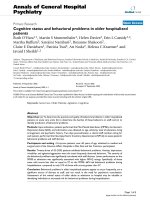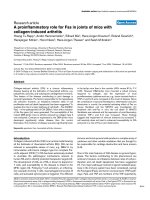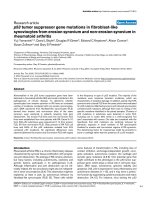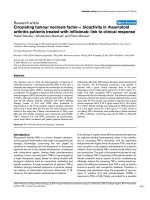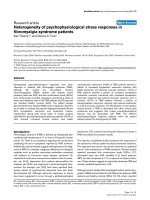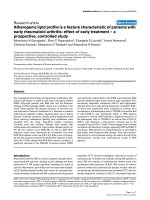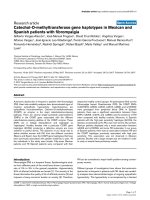Báo cáo y học: "Three novel beta-galactosidase gene mutations in Han Chinese patients with GM1 gangliosidosis are correlated with disease severity" ppsx
Bạn đang xem bản rút gọn của tài liệu. Xem và tải ngay bản đầy đủ của tài liệu tại đây (731.87 KB, 8 trang )
RESEARC H Open Access
Three novel beta-galactosidase gene mutations in
Han Chinese patients with GM1 gangliosidosis
are correlated with disease severity
Chi-Fan Yang
1†
, Jer-Yuarn Wu
1,2†
, Fuu-Jen Tsai
3,4,5*
Abstract
Background: GM1 gangliosidosis (GM1) is an autosomal recessive lysosomal storage disease caused by deficiency
of acid beta-galactosidase (GLB1; EC3.2.1.23). Here, we identify three novel mutations in the GLB1 gene from two
Han Chinese patients with GM1 that appear correlated with clinical phenotype.
Methods: One of the two Han Chinese patients with GM1 presented with the juvenile form, and the other with
the infantile form with cardiac involvement. Sequencing of the entire GLB1 gene revealed three novel mutations
(p.H102 D, p.G494V, c.495_497delTCT), which were absent in 94 normal controls. Transient expression of cDNA
encoding these variants was performed in COS-1 cells to evaluate b-galactosidase activities.
Results: The first case (patient 1) with the juvenile form contained two missense mutations, p.H102 D and p.A301V.
Patient 2 diagnosed with the infantile form of the disease with cardiac involvement was compound heterozygous
for p.G494V and c.495_497delTCT mutations. All mutant beta-galactosidases exhibited significantly reduced activity
(12%, 0%, 0%, and 0% for p.H102 D, p.A301V, p.G494V, and c.495_497delTCT), compared with the wild-type beta-
galactosidase cDNA clone. The mutations identified in patient 2 with cardiomyopathy were localized in the GLB1
gene region common to both lysosomal beta-galactosidase and elastin binding protein (EBP), and caused a
deletion in the elastin-binding domain of EBP.
Conclusions: All four mutati ons identified in Han Chinese patients induce significant suppression of b-
galactosidase activity, correlating with severity of disease and presence of cardiomyopathy.
Introduction
Human b-galactosidase (E.C.3.2.1.23; MIM# 230500) is
an lysosomal enzyme that removes b-ketosidically linked
galactose residues from glycoproteins, sphingolipids, and
keratin sulfate [1]. Deficiency of acid b-galactosidase
leads to two metabolic storage diseases, speci fically, GM1
gangliosidosis (GM1) and Morquio B disease (MBD,
mucopolysaccharidosis type IVB, MPS IVB), inherited as
autosomal recessive traits. In GM1 gangliosidosis,
absence or suppression of b-galactosidase activity causes
excessive accumulation of GM1 ganglioside in neuronal
tissue while b-linked galactose-terminal oligosaccharides
arising from the lysosomal digestion of glycoproteins are
stored in visceral organs andexcretedinurine.Three
major clinical phenotypes have been classified to date:
infantile (type I), late infantile/juvenile (type II), and
adult (type III) forms [1]. The most severe infantile form
with onset between birth and 6 months results in rapidly
progressive c entral nervous system (CNS) degeneration,
visceromegaly, cherry-red spots, skeletal abnormalities,
and death usually occurring within the first two years of
life. Cardiomyopathy is an atypical clinical feature in
some Caucasian patients with infantile GM1 gangliosido-
sis. The residual b-galactosidase activity in fibroblasts
from patients is less th an 1.3%, co mpared to the physio-
logical level. However, the juvenile and adult forms of
GM1 gangliosidosis display a less severe course, later age
of onset, and higher b-galactosidase activity, varying from
0.3 to 4.8% o f the normal level in the juvenile form and
~9% in the adult form [1,2].
* Correspondence:
† Contributed equally
3
School of Post-baccalaureate Chinese Medicine, China Medical University,
Hsueh-Shih Rd., Taichung, Taiwan
Full list of author information is available at the end of the article
Yang et al. Journal of Biomedical Science 2010, 17:79
/>© 2010 Yang et al; licensee BioMed Central Ltd. This is an Open Access article distributed under the terms of the Creative Commons
Attribution License (http: //cre ativecommons.org/licenses/b y/2.0), which permits unrestricted use, distribution, and reproduction in
any medium, provided the original work is properly cited.
In contrast to GM1 gangliosidosis, Morquio B disease
(MBD) is characterized by severe skeletal dysplasia with-
out CNS involvement. MBD is also associated with defi-
ciency of acid b -galactosidase, but the metabolic storage
substance in this c ase is keratin sulfate, a glycosamino-
glycan accumulating in the cornea and skeletal tissue
and secreted in urine, and not GM1 ganglioside in the
brain [1].
The human b-galactosidase gene (GLB1) located on
chromosome 3p21.33 [3] contains 16 exons spanning
approximately 62.5 kb [3,4]. The GLB1 gene encodes two
alternatively spliced produc ts, lysosomal b-galactosidase
(GLB1) and elastin-binding protein (EBP) [5-7]. The GLB1
protein is synthesized as an N-glycosylated 85 kDa precur-
sor, and processed within lysosomes to a 64 kDa mature
enzyme [8-10]. The active enzyme forms complexes with
the 54 kDa protective protein/cathepsin A (PPCA) and the
46 kDa neuraminidase (NEU1) in lysosomes. PPCA is
essential for intracellular transport and intralysosomal
activity/stabilization of both b-galactosidase and N EU1
[11,12]. NEU1 catalyzes hydrolysis of the terminal sialic
acids of oligosaccharides, glycoproteins and glycolipids
[13,14]. The alternative splice product, EBP, results from
deletion of exons 3, 4 and 6, and a frameshift in the trans-
lation of exon 5 encoding the unique elastin binding
domain of EBP [5,15].
Cardiomyopathy in GM1 gangliosidosis is associated
with impaired elastogenesis and EBP defects [16-19]. EBP,
a 67 kDa enzymatically inactive variant of b-galactosidase,
is not targeted to lysosomes. Earlier studies show that EBP
acts as a recycling chaperone that protects tropoelastin
from premature degradation and delivers it through an
intracellular secretory pathway to the cell surface where
tropoelastin is secreted into the extracellular matrix and
assembled [6,20-22]. Tropoelastin is released from EBP
following a conformational change that occurs after the
galactolectin domain of EBP binds to galatosugars pro-
truding from glycoproteins on the microfibrillar scaffold of
growing elastic fibers [6,21]. Following tropoelastin release,
EBP returns to the endosomes, binds to newly synthesized
tropoelastin in the trans-Golgi network, and delivers it to
the cell surface [23]. EBP additionally forms complexes
with PPCA and NEU1 to facilitate elastic fiber assembly
on the cell surface [24]. PPCA appears to act as a protec-
tive protein, while NEU1 is required for the release of tro-
poelastin and the signaling pathway induced by the
complex [25,26].
To date, More than 130 mutations have been identified
in the GLB1 gene [2,27,28]. In this study, w e investigate
the GLB1 mutations associated with GM1 gangliosid osis
in two Han Chinese patients. Three of the mutations iden-
tified in these two pa tients were novel and have not been
reported in patients of other ethnicities. We further evalu-
ate the contribution of individual mutations to the clinical
phenotype via site-directed mutagenesis experiments,
examination of expression levels in COS-1 cells, and
b-galactosidase activity measurements. One of the patients
(patient 2) with cardiac involvement presented two muta-
tions likely to affect both lysosomal GLB1 and EBP pro-
teins, including a deletion in the elastin-binding domain of
EBP. Our findings suggest a correlation between these
mutations and the presence of cardiomyopathy.
Patients and Methods
Patients
The most important clinical features of two GM1 gang-
liosidosis patients are compared in Table 1. Patient 1, a
female, was born after a normal pregnancy. She was the
second child of non-consanguineous healthy parents,
and the family history was non-contributory. The
patient appeared normal at birth. At 6 months of age,
abdominal distention, and subsequently, progressive
developmental regression, delayed psychomotor develop-
ment, and recurrent pulmonary infecti on were observed.
At the age of 18 months, the patient displayed coarse
facial features, thick skin with Mongolian spots, macro-
glossia, hepatosplenomegaly,scoliosis,andprogressive
leukomalacia. MR imaging revealed myelination arrest
in the subcortical white matter, and cortical atropy.
Enzyme assay of cultured fibroblasts disclosed 2% resi-
dual activity compared to the normal level. The patient ’s
clinical condition deteriorated rapidly, and she died of
severe emaciation and hypovolemic shock at 2 years, 2
months of age. Based on residual b-galactosidase activ-
ity, onset age, disease progression and age at death, the
patient was diagnosed with the juvenile form of the dis-
ease [1,2].
Patient 2 presented with the infantile form of the dis-
ease, and was the first child of a healthy non-
consanguineous couple with no contributory family
history. He had developmental retardation, and viscero-
megaly developed soon after birth. At 3 months o f age,
the patient presented with macular cherry-red spots and
hepatomegaly. Hypotonia and bilateral hydrocele were
noted at 4 months of age. The roentgenogram and
echocardiogram findings included cardiomegaly, dilated
cardiomyopathy, hypertrophied left atrium/ventricle, and
poor contractility of the left ventricle. Residual b-galac-
tosidase activity was lower than 1% of the normal level.
MR imaging at 3, 12 and 23 months revealed significant
myelination arrest with dysmyelination of white matter
in the bilateral cerebral hemispheres and atropic change
of the brain cortex [29]. The patient died of congestive
heart failure and seizure at 2 years of age.
Healthy controls were randomly selected from the
Taiwan Han Chinese Cel l and Genome Ba nk [30]. All
participating patients and controls were Han Chinese,
which is the origin of 98% of the Taiwanese population.
Yang et al. Journal of Biomedical Science 2010, 17:79
/>Page 2 of 8
The study was approved by the institutional review
board and the ethics committee of each institution.
Written informed consent was obtained from partici-
pants, in accordance with institutional re quirements and
the Declaration of Helsinki Principles.
Mutation analysis
Genomic DNA was isolated from peripheral blood or
fibroblasts using standard techniques. We sequenced all
exons of the b-galactosidase gene (GLB1), includ ing the
5′ and 3′ untranslated regions and intron/exon bound-
aries. PCR primers were designed using the Primer 3
program />mer3_ww w.cgi. Amplified products from genomic DNA
were purified from the agarose gel using QIAEX II (Qia-
gen, Hilden, Germany), and directly sequenced in both
directions using a BigDye Terminator cycle sequencing
kit with an ABI Prism 377 DNA Sequencer (Applied
Biosystems, Foster City, CA). The GLB1 genomic
sequence was derived from GenBank, NT_022517.16.
Nucleotide numbering was based on the cDNA refer-
ence sequence from GenBank, NM_000404.2, according
to the journal guidelines />men, with A of the ATG start codon as +1.
Construction of the GLB1 expression plasmid, pGS3
Total RNA was extracted from a normal lymphocyte cell
line, and cDNA synthesized using the Advantage
RT-for-PCR kit (Clontech, Pal o Alto, CA) with an oligo-
dT primer. Amplification of wild-type GLB1 gene was
performed with the following oligonucleotides: forward,
5′ -GTCATGCCGGGGTTCCTGGTTC-3′,andreverse,
5′ -GTCCCTGAAGGTGGGGCTTTGG-3′ ,usingthe
Expand™ High Fidelity PCR system (Boehringer
Mannheim, Indianapolis, IN). The 2.21 kb PCR product
was ligated into the TOPO TA cloning kit vector (Invi-
trogen, Carlsbad, CA), and the nucleotide sequence and
orientation of the insert in the resulting plasmid, pTA-
GS, verified by direct sequencing. The HindIII-XbaI
fragment of pTA-GS was further subcloned into the
expression vector, pcDNA3.1 (Invitrogen, Carlsbad, CA),
generating the GLB1 expression plasmid, pGS3.
Construction of mutant b-galactosidase expression
plasmids with deletion and missense mutations
Site-directed mutagenesis using the recombinant poly-
merase chain reaction method [31] was performed to
introduce the p.His102Asp, c.495_497delTCT, p.Ala301-
Val, and p.Gly494Val mutations into wild-type GLB1
cDNA. W ild-type pGS3 was employed as the template,
and the primers used for site-directed mutagenesis are
presented in Table 2. Nucleotide sequences of the
resulting mutant GLB1 expression plasmids, pGS3-H102
D, pGS3-c.495_497delTCT, pGS3-A301V and pGS3-
G494V, were confirmed for the entire coding region via
direct sequencing.
Table 1 Clinical and molecular features of two Taiwanese patients with GM1 gangliosidosis
Patient 1 Patient 2
Phenotype Juvenile Infantile
Age of onset 6 months Birth
Age at
diagnosis
18 months 4 months
Presentation Developmental regression, delayed psychomotor development, coarse facial
features, macroglossia, abdominal distention, and thick skin with Mongolian
spots
Developmental regression, hypotonia, bilateral
hydrocele, and visceromegaly
Eye Normal Cherry red spot
Heart Normal Dilated cardiomyopathy, Hypertrophied left atrium/
ventricle, and poor contractility of left ventricle
Skeleton Scoliosis and beaking of the lumbar vertebral bodies Normal
Liver/spleen Hepatosplenomegaly Hepatomegaly
Nervous
system
White matter demyelination and cortical atropy White matter demyelination, cortical atropy, and
seizure
Bone marrow Foamy histiocytes and progressive leukomalacia Foamy histiocytes
Age of death 2 years, 2 months 2 years
b-
galactosidase
activity
2% of control value in fibroblast <1% of control value in fibroblast
Genetic defect
Allele 1 c.304C>G (p.H102 D, inherited from father) c.495_497delTCT (p.L166del, inherited from mother)
Allele 2 c.902C>T (p.A301V, inherited from mother) c.1481G>T (p.G494V, inherited from father)
Polymorphisms p.L10P p.L10P
Yang et al. Journal of Biomedical Science 2010, 17:79
/>Page 3 of 8
Transient transfection of COS-1 cells
COS-1 cells were cultured in DMEM and 10% fetal bovine
serum supplemented with 100 U/ml penicillin, 100 μg/ml
streptomycin and 2 mM L-glutamine. Cells were grown to
85-90% confluency in each well of a 6-well plate, and
separately transfected with 4 μg of pGS3-H102 D, pGS3-
c.495_497delTCT, pGS3-A301V, pGS3-G494V and
wild-type pGS3. Transfection was performed using the
Lipofectamine™ 2000 reagent (Gibco BRL, Grand Island,
NY), according to the manufacturer’s instructions. After
48 h incubation at 37°C, cells were scraped and washed
twice with PBS. Cell pellets were frozen at -70°C until use
for protein content determination and assay of enzyme
activity.
Enzyme assays
Transfected cells were resuspended in distilled water, and
subjected to sonication using a Misonix Ultrasonic proces-
sor (XL2020) at a power level of 10 for 15 s in ice. Soluble
lysates were collected and protein concentrations deter-
mined using the Bio-Rad assay kit (Hercules, CA) with
bovine serum albumin as a standard. The GLB1 enzyme
assay was performed using the artificial substrate, 4-methy-
lumbelliferyl- b-D-galactopyranoside (Sigma, St. Louis,
MO) [32,33]. Briefly, b-galactosidase activity was measured
in duplicate by adding 100 μl of enzyme solution to 300 μl
of 0.65 mM substrate solution (4-methylumbelliferyl-b-D-
galactopy ranoside in 0.1 M citrate-phosphate buffer, pH
4.2). After incubation at 37°C for 1 h, all reactions were
terminated by adding 1 ml of 0.1 M 2-methylpropan-1-ol,
pH 10. Fluorescence was determined with a PerSeptive
Biosystems (Cytofluor® series 4000) fluorescence multi-well
plate rea der (Applied Biosystems, Foster City, CA). A
known amount of 4-methylumbel liferone (Sigma, St.
Louis, MO) in 0.1 M 2-methylpropan-1-ol, pH 10, was
employed as the standard.
Results
Molecular analysis of GM1-gangliosidosis patients
Genomic DNA from two Han Chinese p atients with
GM1 was amplified wit h a view to screening all 16
exons and splice junctions of the GLB1 gene via direct
sequencing. In total, one deletion, three missense
mutations and one polymorphism were identified
(Tables 1 and 2). Among these, three mutations
(p.H102 D, p.G494V, and c.495_497delTCT) were
novel. Patient 1 diagnosed with the juvenile form of
GM1 contained two mutations, specifically, c.304C > G
in exon 3 (p. H102D) and c. 902C > T in exon 8
(p. A301V)[28] (Fig.1A and 1B), as well as one poly-
morphism in exon 1, hom ozygous p.L10P polymorph-
ism (rs.7637099, data not shown). Patient 2 presenting
with the infantile form of the disease contained a 3 bp
in-frame deletion in exon 5, resulting in deletion of a
residue, both in the GLB1 protein (c.495_497delTCT,
p. L166del, F ig. 1D) and elastin-binding domain of the
EBP protein (c.283_285delTCT, p.S95del, Fig.2).
Another nucleotide mutation, c.1481G > T in exon 15,
led to the generation of p.G494V (Fig. 1C). Patient 2
was heterozygous for the p.L10P polymorphism (data
not shown). These variations in the GLB1 gene were
confirmed in parent genomic DNA (Table 1). The
p.L10P polymorphism was identified in the 94
normal Han Chinese subjects at an allele frequency of
47.3% (87 of 184 alleles) while the p.His102Asp,
c.495_497delTCT (p.Leu166del), p.Ala301Val, and p.
Gly494Val variants were absent in the 94 normal Han
Chinese subjects. Alignment of the GLB1 sequences
from human, mouse, rat, cow, cat, dog, and chicken
revealed that p.Leu166, Ala301, and Gly494 are con-
served throughout these specie s. All residues corre-
sponding to human p.His102 among the species
examined are basic (histidine, arginine or glutamine)
whereas mutant p.Asp102 contains an acidic residue
(Fig. 3). Gene variants were further analyzed for func-
tional consequences on GLB1 enzyme activity in COS-
1 cells.
Transient expression of GLB1 plasmids in COS-1 cells
Expression patterns of these variant constructs in COS-1
cells w ere compared to those transfected with the nor-
malGLB1clone,pGS3(Table3).TheGLB1enzyme
Table 2 Primers used for site-directed mutagenesis
Genetic variation Amino acid change Exon Oligonucleotides (5’ -> 3’)
c.304C>G p.His102Asp 3 F: AACTGGTACTGTCCTGGCCAGGGCTCATGAAAGTTCCAG
R: CCTGGCCAGGACAGTACCAGTTTTCTGAGGAC
GATGATGTGGAATATTTTC
c.495_497delTCT p. L166del 5 F: ACCACTTGTCCACAGCTGCCAGGTAATCTGGGTCGGAGG
R: CTGGCAGCTGTGGACAAGTGGTTGGGAGTCCT—GCCCAAGATGAAGCCTC
c.902C>T p.Ala301Val 8 F: AAGTATATCATAGAGGGAGGAAGCCAC
TGCTTCGGTCTTG
R: TTCCTCCCTCTATGATATACTTGCCCGTGGGGTGAGTGTGAACTTGTACATG
c.1481G>T p.Gly494Val 15 F: GTTGATATATGCACCATAGTTCACACGTCCCATGTTCTC
R: GAACTATGGTGCATATATCAACGATTTTAAGG
TTTTGGTTTCTAACCTG
1
Nucleotide changes are marked with an underline (nucleotide substitution) or a string of hyphens (deletion).
Yang et al. Journal of Biomedical Science 2010, 17:79
/>Page 4 of 8
activities of cells transfected with pGS3-H102 D, pGS3-
c.495_4 97delTCT, pGS3-A301V, and pGS3-G494V were
12%, 0%, 0%, and 0%, compared to those transfected
with the control plasmid (pGS3), respectively.
Discussion
More than 130 mutations in the GLB1 gene have been
reported in GM1 or MBD cases from Japan, Northern/
Southern America, and Europe. The majority of muta-
tions appear to cluster in exons 2, 6, and 15 of the
GLB1 gene [2]. These “hotspot” regions play important
catalytic and/or regulatory roles. Here, we perform
mutational analysis of two Han Chinese patients with
GM1. Clinical manifestations of the patients can be
distinguished according to the presence or absence of
cardiac involvement. This atypical clinical feature has
Figure 1 Nucleotide sequences of the neighboring regions of the mutati ons in the GLB1 gene of two GM1 gangliosidosis patients.
The mutant sequencing diagrams are shown. The position of each mutation is marked with an arrow (panels A-D). Wild-type and mutant
nucleotide and amino acid sequences are presented using A of the ATG start codon of GLB1cDNA as position +1.
Figure 2 Schematic representation of alternatively spliced mRNA of the GLB1 gene encoding EBP. The unique 32 amino acid region
encoded by a frameshift in exon 5 contains an elastin/laminin-binding domain (underlined). The 3 bp in-frame deletion resulting in p.S95del is
enclosed within a square.
Yang et al. Journal of Biomedical Science 2010, 17:79
/>Page 5 of 8
been reported in limited Caucasian patients. Three
mutations in the GLB1 gene identified from the entire
pathogenic allele of these two patients have not been
reported previously. The variable severity of these clini-
cal manifestations correlates with the mutation combi-
nations. Patient 1, diagnosed with juvenile GM1
gangliosidosis without cardiomyopathy, is compound
heterozygous for p.H102 D in exon 3 and p.A301V in
exon 8, respectively. Although substitution of valine at
position 301 with alanine seems to be homologous and
non-deleterious, COS-1 cells expressing cDNA encoding
p.A301V in vitro displayed no GLB1 enzyme activity.
Low enzyme activity (~12% of the physiological level)
was detected in COS-1 cells transfected with cDNA
encoding the p.H102 D substitution. The p.H102 D
appears to be a mild mutation responsible for the less
severe phenotype of our juven ile patient displaying 2%
residual enzyme activity. The p.A301V has been found
in our patient 1 and in another juvenile patient [28],
bot h presenting juvenile GM1 with central nervous sys-
tem involvement and skele talaffectionaswellas
absence of cardiac dysfunction and cherry red spots.
The p.H102 D alone or combined with p.A301V can be
related to hepatosplenomegaly.
Both c.495_497delTCT and p.G494V mutations identi-
fied in patient 2 led to absence of GLB 1 enzyme activity
in transient expression studies, correlating with lack of
in vivo residual enzyme activity (<1%). Two transcripts
are processed from the primary b-galactosidase tran-
script, specifically, the classical lysosomal form of 677
amino acid b-galactosidase (GLB1) and t he elastin bind-
ing protein (EBP) containing 546 residues in which
exons 3, 4, a nd 6 are spliced out from pre-mRNA and
exon 5 is frameshifted [5]. The frameshift in exon 5
results in a unique form of EBP, a 32-resi due sequence
containing an elastin/laminin-binding domain [15]. The
two h eterozygous mutations identified in patient 2 dis-
playing cardiac involvement are localized in the GLB1
gene region comm on to the two transcripts, and thus
affects both the lysosomal GLB1 enzyme and EBP pro-
tein. Both mutations can b e related to infantil e GM1
with cardiac dysfunction, as well as central nervous sys-
tem involvement, cherry red spots and lack of skeletal
affection.
The c.495_497delTCT mutation of the GLB1 tran-
script corresponds to a c.283_285delTCT variation of
the EBP transcript, leading to in-frame deletion of an
amino acid, p.Ser95del, in the elastin/laminin-binding
domain of EBP. This variation i n the elastin-binding
domain of the EBP protein may directly impair tropoe-
lastin binding to EBP and assembly of elastic fibers,
which are consequently linked to the patient’ s cardiac
involvement. Our data additionally support an associa-
tion of EBP with cardi ac involvement in GM1 gangliosi-
dosis [16-19].
Conclusions
We identified three novel genetic mutations in the
GLB1 coding region from Chinese patients with GM1.
Patient 1 presented with the juvenile form of GM1 and
2% residual b-galactosidase activity in cultured fibro-
blasts. Expression of the two GLB1 mutants identified in
patient 1, p.H102 D and p.A301V, in COS-1 cells led to
12% and 0% of normal activity. Patient 2 presented with
the infantile form of GM1 and less than 1% of residual
b-galactosidase activity in cultured fibroblasts. The two
mutants, p.G949V and c.934-7del (p.L166del), identified
from patient 2 were devoid of activity upon expression
in COS-1 cells. The two mutations in patient 2 were
localized in the GLB1 gene region common to lysosomal
GLB1 and EBP, and could therefore affect both proteins.
All the mutations correlated with the clinical manife sta-
tionsofpatientsandresidualb-galactosidase activity in
cultured fibrob lasts. While elastic fiber deposition
requires further evaluation in patients, it is plausible
Figure 3 Alignment of the GLB1 homologs of six species
around the H102 D variants indicated by squares http://www.
ebi.ac.uk/Tools/clustalw/index.html. *Total sequence homology;:
Very high homology;. High homology.
Table 3 b-Galactosidase activity measured in transiently
transfected COS-1 cell lysates
Vector name Specific Activity (nmol/
hr/mg of protein)
1
Percentage of wild-
type activity
2
Controls
None 320 ± 21.1 0
pGS3 wt 534 ± 27.7 100
Variants
pGS3-H102D 346 ± 19.4 12
pGS3-
c.495_497delTCT
237 ± 14.5 0
pGS3-A301V 260 ± 20.3 0
pGS3-G494V 294 ± 27.5 0
1
Enzyme activities are presented as average values of two independ ent
experiments, as described in the Patients and Methods section.
2
Specific activities were obtained after subtraction of activity in mock-
transfected COS-1 cells measured as a baseline co ntrol in each experiment.
Yang et al. Journal of Biomedical Science 2010, 17:79
/>Page 6 of 8
that impaired elastogenesis and cardiomyopathy in GM1
gangliosidosis are caused by defects in the elastin-bind-
ing domain of EBP.
Abbreviations
GM1: GM1 gangliosidosis; GLB1: beta-galactosidases; EBP: elastin binding
protein; PPCA: protective protein/cathepsin A; NEU1: neuraminidase.
Acknowledgements
The authors are grateful to the patients and their parents for their
participation in the study. This work was supported by China Medical
University Hospital (grant number: DMR-92-079), Taichung, Taiwan and the
National Science Council (grant number: NSC 89-2314-B-039-003), Taipei,
Taiwan.
Author details
1
Institute of Biomedical Sciences, Academia Sinica, Academia Road, Nankang,
Taipei, Taiwan.
2
Graduate Institute of Chinese Medical Science, China Medical
University, Hsueh-Shih Rd, Taichung, Taiwan.
3
School of Post-baccalaureate
Chinese Medicine, China Medical University, Hsueh-Shih Rd., Taichung,
Taiwan.
4
Department of Medical Genetics, Pediatrics and Medical Research,
China Medical University Hospital, Yuh-Der Rd., Taichung, Taiwan.
5
Department of Biotechnology and Bioinformatics, Asia University, Liufeng
Rd., Wufeng, Taichung, Taiwan.
Authors’ contributions
JYW conceived and designed the study. CFY performed molecular analysis
and transient expression, and drafted the manuscript. FJT participated in the
design of the study and critically reviewed the draft. All authors have read
and approved the final manuscript.
Competing interests
The authors declare that they have no competing interests.
Received: 5 May 2010 Accepted: 30 September 2010
Published: 30 September 2010
References
1. Suzuki Y, Oshima A, Namba E: GM1-gangliosidosis and Morquio B disease
New York: McGraw-Hill, 8 2001.
2. Brunetti-Pierri N, Scaglia F: GM1 gangliosidosis: review of clinical,
molecular, and therapeutic aspects. Mol Genet Metab 2008, 94:391-396.
3. Yamamoto Y, Hake CA, Martin BM, Kretz KA, Ahern-Rindell AJ, Naylor SL,
Mudd M, O’Brien JS: Isolation, characterization, and mapping of a human
acid beta-galactosidase cDNA. DNA Cell Biol 1990, 9:119-127.
4. Morreau H, Bonten E, Zhou XY, D’Azzo A: Organization of the gene
encoding human lysosomal beta-galactosidase. DNA Cell Biol 1991,
10:495-504.
5. Morreau H, Galjart NJ, Gillemans N, Willemsen R, van der Horst GT,
d’Azzo A: Alternative splicing of beta-galactosidase mRNA generates the
classic lysosomal enzyme and a beta-galactosidase-related protein. J Biol
Chem 1989, 264:20655-20663.
6. Hinek A: Biological roles of the non-integrin elastin/laminin receptor. Biol
Chem 1996, 377:471-480.
7. Privitera S, Prody CA, Callahan JW, Hinek A: The 67-kDa enzymatically
inactive alternatively spliced variant of beta-galactosidase is identical to
the elastin/laminin-binding protein. J Biol Chem 1998, 273:6319-6326.
8. D’Azzo A, Hoogeveen A, Reuser AJ, Robinson D, Galjaard H: Molecular
defect in combined beta-galactosidase and neuraminidase deficiency in
man. Proc Natl Acad Sci USA 1982, 79:4535-4539.
9. Nanba E, Tsuji A, Omura K, Suzuki Y: GM1-gangliosidosis: abnormalities in
biosynthesis and early processing of beta-galactosidase in fibroblasts.
Biochem Biophys Res Commun 1988, 152:794-800.
10. van der Spoel A, Bonten E, d’Azzo A: Processing of lysosomal beta-
galactosidase. The C-terminal precursor fragment is an essential domain
of the mature enzyme. J Biol Chem 2000, 275:10035-10040.
11. Morreau H, Galjart NJ, Willemsen R, Gillemans N, Zhou XY, d’Azzo A:
Human lysosomal protective protein. Glycosylation, intracellular
transport, and association with beta-galactosidase in the endoplasmic
reticulum. J Biol Chem 1992, 267:17949-17956.
12. Bonten E, van der Spoel A, Fornerod M, Grosveld G, d’Azzo A:
Characterization of human lysosomal neuraminidase defines the
molecular basis of the metabolic storage disorder sialidosis. Genes Dev
1996, 10:3156-3169.
13. Achyuthan KE, Achyuthan AM: Comparative enzymology, biochemistry
and pathophysiology of human exo-alpha-sialidases (neuraminidases).
Comp Biochem Physiol B Biochem Mol Biol 2001, 129
:29-64.
14. Seyrantepe V, Poupetova H, Froissart R, Zabot MT, Maire I, Pshezhetsky AV:
Molecular pathology of NEU1 gene in sialidosis. Hum Mutat 2003,
22:343-352.
15. Hinek A, Rabinovitch M, Keeley F, Okamura-Oho Y, Callahan J: The 67-kD
elastin/laminin-binding protein is related to an enzymatically inactive,
alternatively spliced form of beta-galactosidase. J Clin Invest 1993,
91:1198-1205.
16. Morrone A, Bardelli T, Donati MA, Giorgi M, Di Rocco M, Gatti R, Parini R,
Ricci R, Taddeucci G, D’Azzo A, Zammarchi E: beta-galactosidase gene
mutations affecting the lysosomal enzyme and the elastin-binding
protein in GM1-gangliosidosis patients with cardiac involvement. Hum
Mutat 2000, 15:354-366.
17. Hinek A, Wilson SE: Impaired elastogenesis in Hurler disease: dermatan
sulfate accumulation linked to deficiency in elastin-binding protein and
elastic fiber assembly. Am J Pathol 2000, 156:925-938.
18. Caciotti A, Donati MA, Boneh A, d’Azzo A, Federico A, Parini R, Antuzzi D,
Bardelli T, Nosi D, Kimonis V, et al: Role of beta-galactosidase and elastin
binding protein in lysosomal and nonlysosomal complexes of patients
with GM1-gangliosidosis. Hum Mutat 2005, 25:285-292.
19. Caciotti A, Donati MA, Bardelli T, d’Azzo A, Massai G, Luciani L,
Zammarchi E, Morrone A: Primary and secondary elastin-binding protein
defect leads to impaired elastogenesis in fibroblasts from GM1-
gangliosidosis patients. Am J Pathol 2005, 167:1689-1698.
20. Hinek A, Rabinovitch M: 67-kD elastin-binding protein is a protective
“companion” of extracellular insoluble elastin and intracellular
tropoelastin. J Cell Biol 1994, 126:563-574.
21. Hinek A: Nature and the multiple functions of the 67-kD elastin-/laminin
binding protein. Cell Adhes Commun 1994, 2:185-193.
22. Hinek A, Wrenn DS, Mecham RP, Barondes SH: The elastin receptor: a
galactoside-binding protein. Science 1988, 239:1539-1541.
23. Hinek A, Keeley FW, Callahan J: Recycling of the 67-kDa elastin binding
protein in arterial myocytes is imperative for secretion of tropoelastin.
Exp Cell Res 1995, 220:312-324.
24. Pshezhetsky AV, Ashmarina M: Lysosomal multienzyme complex:
biochemistry, genetics, and molecular pathophysiology. Prog Nucleic Acid
Res Mol Biol 2001, 69:81-114.
25. Hinek A, Pshezhetsky AV, von Itzstein M, Starcher B: Lysosomal sialidase
(neuraminidase-1) is targeted to the cell surface in a multiprotein
complex that facilitates elastic fiber assembly. J Biol Chem 2006,
281
:3698-3710.
26. Duca L, Blanchevoye C, Cantarelli B, Ghoneim C, Dedieu S, Delacoux F,
Hornebeck W, Hinek A, Martiny L, Debelle L: The elastin receptor complex
transduces signals through the catalytic activity of its Neu-1 subunit.
J Biol Chem 2007, 282:12484-12491.
27. Hofer D, Paul K, Fantur K, Beck M, Burger F, Caillaud C, Fumic K,
Ledvinova J, Lugowska A, Michelakakis H, et al: GM1 gangliosidosis and
Morquio B disease: expression analysis of missense mutations affecting
the catalytic site of acid beta-galactosidase. Hum Mutat 2009,
30:1214-1221.
28. Hofer D, Paul K, Fantur K, Beck M, Roubergue A, Vellodi A, Poorthuis B,
Michelakakis H, Plecko B, Paschke E: Phenotype determining alleles in
GM1 gangliosidosis patients bearing novel GLB1 mutations. Clin Genet
2010, 78(3):236-246.
29. Lin HC, Tsai FJ, Shen WC, Tsai CH, Peng CT: Infantile form GM1
gangliosidosis with dilated cardiomyopathy: a case report. Acta Paediatr
2000, 89:880-883.
30. Pan WH, Fann CS, Wu JY, Hung YT, Ho MS, Tai TH, Chen YJ, Liao CJ,
Yang ML, Cheng AT, Chen YT: Han Chinese cell and genome bank in
Yang et al. Journal of Biomedical Science 2010, 17:79
/>Page 7 of 8
Taiwan: purpose, design and ethical considerations. Hum Hered 2006,
61:27-30.
31. Ansaldi M, Lepelletier M, Mejean V: Site-specific mutagenesis by using an
accurate recombinant polymerase chain reaction method. Anal Biochem
1996, 234:110-111.
32. Zhang S, Bagshaw R, Hilson W, Oho Y, Hinek A, Clarke JT, Callahan JW:
Characterization of beta-galactosidase mutations Asp332– > Asn and
Arg148– > Ser, and a polymorphism, Ser532– > Gly, in a case of GM1
gangliosidosis. Biochem J 2000, 348(Pt 3):621-632.
33. Hubbes M, D’Agrosa RM, Callahan JW: Human placental beta-
galactosidase. Characterization of the dimer and complex forms of the
enzyme. Biochem J 1992, 285(Pt 3):827-831.
doi:10.1186/1423-0127-17-79
Cite this article as: Yang et al.: Three novel beta-galactosidase gene
mutations in Han Chinese patients with GM1 gangliosidosis are
correlated with disease severity. Journal of Biomedical Science 2010 17:79.
Submit your next manuscript to BioMed Central
and take full advantage of:
• Convenient online submission
• Thorough peer review
• No space constraints or color figure charges
• Immediate publication on acceptance
• Inclusion in PubMed, CAS, Scopus and Google Scholar
• Research which is freely available for redistribution
Submit your manuscript at
www.biomedcentral.com/submit
Yang et al. Journal of Biomedical Science 2010, 17:79
/>Page 8 of 8
